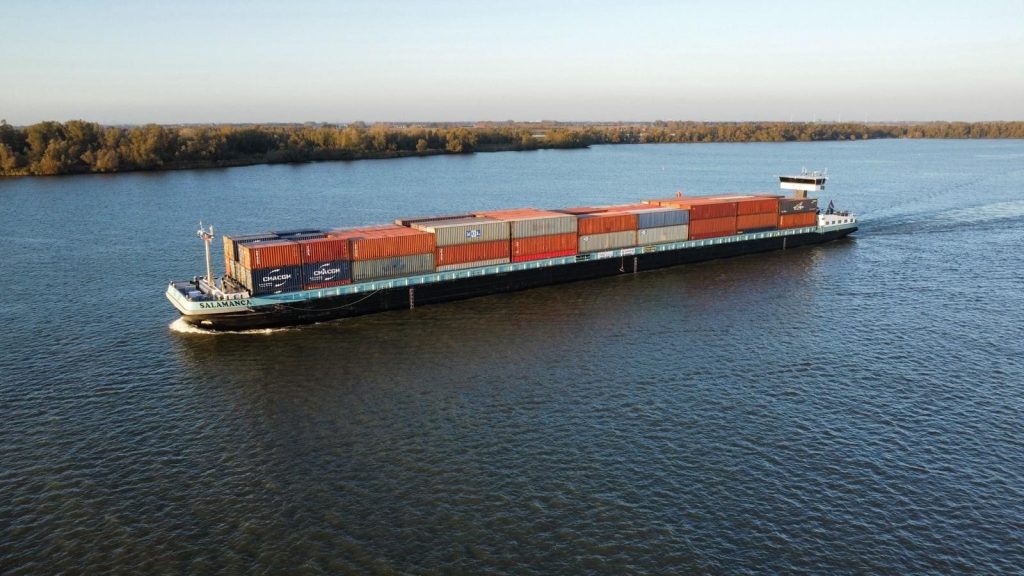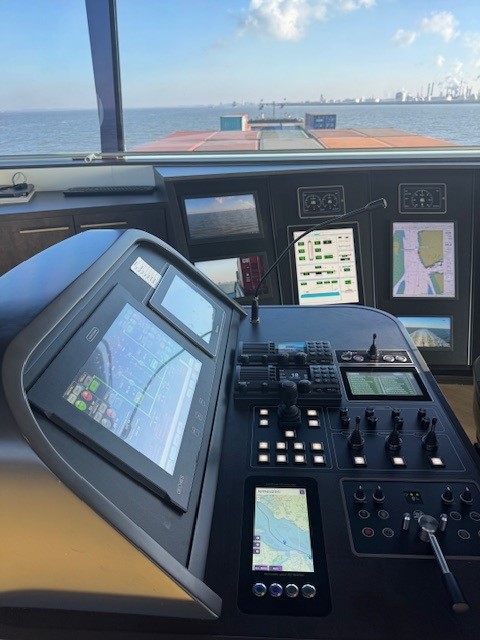Client Case: Salamanca
Danny van Deurzen is the proud captain and co-owner of the Salamanca, together with his partner Ilse van de Sanden. The Salamanca is a container vessel measuring 135 meters in length and 14.20 meters in width. With a capacity of 5,684 tons, it transports goods daily along the North Sea Port route, from Vlissingen to Rotterdam. For four years now, the vessel has been part of the Merlin Group fleet and has been sailing non-stop for charterer Danser.

From Tradition to Entrepreneurship
With inland shipping in his blood, Danny grew up in a family where vessels and inland navigation were central. “On my mother’s side, everyone comes from inland shipping. I’ve been involved since I was very young, without it ever really being the plan,” he explains. In 2000, together with a partner, he took the step toward owning his own tanker. Although that vessel was later sold, the desire for entrepreneurship never left him.
Through his uncle, Danny came into contact with Jan Kleine of the Merlin Group. After working together with Jan for six months, they decided to become co-owners of the old Salamanca. Two years later, they were given the opportunity to start a newbuild project. “We seized that opportunity with both hands,” he says proudly. And that’s how the current Salamanca became a reality.
Introduction to ST
Through Jan, Danny was introduced to Shipping Technology. “Jan had ST’s products installed on the Tripoli, one of the vessels of the Merlin Group. He was very positive about it: it works perfectly, you can monitor everything and track your consumption. Especially for the future of our clients, that’s important, because they want to be able to monitor emissions per tonnage,” he explains.
At the Maritime Industry trade fair, they visited the Shipping Technology booth. “We received an explanation there, and I found it to be a very advanced system. We already had a track pilot from a competitor, but ST’s system was truly a complete package. The decision to install it on the Salamanca was quickly made,” he says. Since January 2024, the Salamanca has been using all ST products.
Autonomous Lane Assist (ALA) in Action
On the Salamanca, Danny makes extensive use of the ALA: “To be honest, I use the ALA the most — actually on a daily basis.” Especially on long stretches like the Westerschelde, the ALA is indispensable. “You switch it on and of course you keep an eye on everything, but it tracks everything perfectly. It stays right on course, even in the fog. I think it sails more precisely than I would myself,” he admits.
The ST ALA uses historical data and AI to enable autonomous sailing within a smartly generated track, entirely independent of an internet connection. The captain doesn’t need to configure anything; he can simply plan and activate the route.
According to him, the ALA has not only increased comfort but also safety: “The ALA calculates everything in advance and gives timely warnings of potential collisions. Of course, it remains a tool; the system signals you, but you’re still in charge. For now, it’s a valuable assistant on our routes.”

The Future of Autonomous Sailing
Initially, Danny was skeptical about autonomous sailing. “I thought it was a big fantasy story. My first thought was: yeah, right. At first, it takes some getting used to, but now it feels very familiar, and you can see that it’s all possible.”
Although he is enthusiastic about the technology, he remains realistic: fully autonomous sailing is still something for the future. “There are still some updates needed before we can truly talk about fully autonomous sailing. But I do believe this is the future. It’s coming closer faster than you think,” he says. Especially given today’s staffing challenges, Danny sees autonomous sailing as a very promising solution for the future.
Evidence Against Incident Accusation
In the Margriethaven near Rotterdam, the Salamanca found itself in a difficult situation after an accusation that caused much uncertainty. “We were waiting at the Maasvlakte around midnight when our daughter came running into our room, saying that we had broken loose,” he recalls. He rushed upstairs to start the vessel, and once it was secured again, the neighbor accused the Salamanca of having caused damage by breaking free. “We immediately had a bad feeling about it,” says Danny.
Afterwards, Danny remembered that ST had stored the camera footage. “We called ST and explained our situation. They reviewed everything and sent us a clip of that specific moment, including all the camera footage and data,” he explains.
The evidence was crystal clear: “The footage shows that something had already been happening with the neighbor’s vessel for half an hour, while we hadn’t done anything. The neighbor had moved his vessel using his engines, which caused the Salamanca’s ropes to break. Thanks to ST’s systems, we were able to see exactly what had happened,” he explains.
The footage was crucial for the insurance company, which immediately recognized what had actually happened. “The data doesn’t lie. In a situation like this, I’m glad we have a system that makes everything visible,” he adds.
In conclusion, Danny adds: “ST really asks what the customer wants and builds on that. That feels reassuring,” he explains. For him, the human aspect is just as important: “It’s about working with people, and that personal contact makes the difference. You can see the passion behind it, and that’s what I value most about Shipping Technology.”
Do you want to take your fleet to the next level?
Curious how our technology can make your vessel more efficient, safer, and more sustainable?
